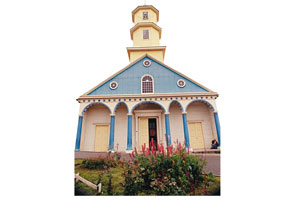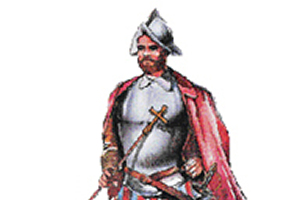Province of Osorno
– Osorno: provincial capital. It was founded on 1553 by Francisco de Villagra. Its main tourist ttractions are the San Mateo Cathedral (built on 1587), the Municipal Historical Museum, that has a sector preserving huilliches objects, another about the conquest and the repopulation of the city and an area dedicated to Eleuterio Ramirez, hero of the Pacific War born in this zone. There is also the San Luis de Osorno or Reina Luisa fortress which was built by Ambrosio O´Higgins on 1793.
– Puerto Octay: is a locality situated at the Llanquihue Lake’s northern shore and among its main attractions are beautiful beaches such as Las Cascadas, Islote Rupanco, La Baja, Maiten and Puerto Fonck. Besides, there is the El Colono Museum, that shows part of the history of the German settlement and at the Osorno volcano slopes are the La Picada ski slopes.
– Entre Lagos: is a village located at 46 km from Osorno with 3.358 inhabitants. At the beginning of the past century was a forestry port, though, nowadays its main activity is tourism since it is the entrance to the Puyehue Lake and to the likewise named springs and to the Aguas calientes springs. Other places for visiting are the Antiollanca, Coto Rupanquito and Punta Ñilque ski resorts.
– Purranque: this location, which is found 38 km south of Osorno, was founded in 1911. It is known because every January 20th, the festivity of San Sebastian is celebrated, one of the most important festivities of the area, for it gathers thousands of people.
– Maicolpue: this beach community is located 65 km west of Osorno. It is known for its white sand beaches and because it is surrounded by native forests that reach all the way to the coast.
– Pucatrihue: this bathing area, located 69 km west of Osorno, has a high turnout during the summer season. It has a 3 km beach, dunes and cliffs.
Province of Llanquihue
– Puerto Montt: it is the capital of the province and was founded in 1853 by Vicente Perez Rosales to provide support to the German colonization. Its main tourist attractions are the cathedral, the plaza that faces the ocean, Pelluco beach and the pier, where one may see the bay of Puerto Montt. Five blocks away from this last place there are three monuments: one is related to the German settlers; one refers to a chilota craft and the other to the first locomotive that traveled to Puerto Varas and Llanquihue.
– Angelmo: this cove, which is located a mere 2 km from downtown Puerto Montt, is known for its fish and shellfish market, the largest in the country. It also has a handicraft fair where one may find all kinds of products that are common to the area. In addition, dinghies and ferries set sail from here that head to Chiloe, Aisen, San Rafael lagoon and Puerto Natales.
– Puerto Varas: this city is located 20 km from Puerto Montt, on the southeast bank of lake Llanquihue. It is also known as the “city of roses” due to the abundant amount of flowers on its streets. Its main attractions are its German cuisine, especially its pastries; the Sagrado Corazon de Jesus church, the Lutheran church, the gaming casino and the Puerto Chico sector, where there are constructions from the early XX century. In addition, from here, one may access Peulla international pass, which leads to Bariloche and the Petrohue falls.
– Llanquihue: this location is located 6 km from Puerto Varas, on the western bank of the lake that bears the same name. It is famous for its sausages and beer. In January, a traditional German beer festival known as Oktoberfest is celebrated.
– Carelmapu: this fishermen town is located 85 km southeast of Puerto Montt and has 2,840 inhabitants. It was founded in 1602 by the Spaniards and its main attractions are the Church of the Candelaria –declared a National Monument in 1986- and Mar Brava beach, which has several cliffs.
– Maullin: this comuna (county), which has 15,580 inhabitants, is found 70 km southeast of Puerto Montt. Here, one may visit the Nuestra Señora del Rosario Church (built in 1895) and Pangal, a bathing area with an extensive beach that is surrounded by forests.
– Ensenada: 50 km from Puerto Varas, southeast of lake Llanquihue, this location stands out for its crystalline, albeit very cold, waters.
Province of Palena
– Hornopiren: this place, which is 109 km from Puerto Montt, is the gateway for visiting Hornopiren volcano (1,572 masl) and other attractive spots, such as Hornopiren National Park and the sectors of Chaqueihua, Cholgo and Pinchaco.
– Amarillo Hot Springs: they are located 25 km from Chaiten and are famous for their thermal waters, which come from Michimahuida volcano.
– Puerto Cardenas: it is found on the far western end of lake Yelcho, 47 km from Chaiten. It is known for its fly fishing.
– Villa Santa Lucia: this location is found 30 km south of Puerto Cardenas, nearly on the border with Argentina. It is internationally renowned by kayak enthusiasts, for the Futaleufu river is considered one of the toughest for those who practice the sport.
Province of Chiloe
This province considers the entire archipelago of the same name, and is made up by the Isla Grande of Chiloe (Great Island of Chiloe) and more than 40 small islands. Its main tourist attractions are:
– Ancud: this comuna (county) is located northeast of the island. It was founded on August 20th 1768. A few of its attractions are fort San Antonio and fort Ahui, which preserves 14 cannons, and the Museo Azul de las Islas de Chiloe (Blue Museum of the Islands of Chiloe). The latter has representations of mythological beings made out of cancagua stone, as well as a replica of the chilota schooner called Ancud, which took possession of the straight of Magellan in 1843.
– Castro: capital of the province, it is located 174 km from Puerto Montt. It was founded on February 12th, 1567 by Spaniard Martin Ruiz de Gamboa. Its main tourist attraction are the palafitos (dwellings above water), the Castro Regional Museum, which has a great collection of chilote objects, the Museum of Modern Art and the Apostol Santiago and San Francisco de Castro churches, which were declared World Heritage Sites by Unesco in 1993. In addition, the Municipal Park is located in the highlands on the city, where the Festival Costumbrista Chilote (Chilote Customs Festival) every summer.
– Quemchi: it is a small fishing cove found on the north shore of Chiloe. Its main attractions are its picturesque streets, the coastal road, the municipal textile factory, its miniature ships handicrafts and the mausoleum of the Coloane family.
– Chonchi: founded in 1767 under the name Villa San Carlos de Chonchi, it is found 20 km from Castro. It is known as the three storey city, because it is located on the slope of a hill that has three terraces. It is characterized by its constructions made out of cypress wood and painted in eye-catching colors and the sale of typical products, like licor de oro (gold liquor), cherry liquor and chonchina doughnuts (sweet bread). In addition, one may visit the churches of San Carlos de Corroneo and Vilupulli, which were declared National Monuments in 1971. The Fiesta Criolla de Chonchi (Chonchi Criollo Festivity) is held in the month of February.
– Dalcahue: it is located 25 km from Castro, along the coast that leads to the gulf of Ancud. Its name comes from Mapudungun and means place of dalcas, which were sea vessels made out of three planks tied together which were used by the chonos. Its main attractions are the churches of Dalcahue, San Juan and Tenuan and the handicrafts fair that is held on Thursdays and Sundays.
– Queilen: it is located 46 km from Chonchi and its main tourist attraction are the beaches with fine, crystalline waters, were one may practice water sports.
– Quellon: it is the island’s southernmost town, located 92 km south of Castro. It serves has a docking station for the ferries that head to Chaiten and Aisen. On Mondays and Fridays and fair takes place where the locals sell their handicrafts.








